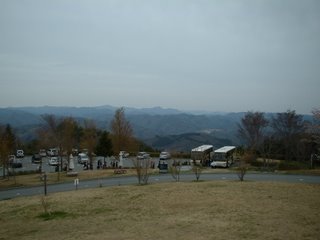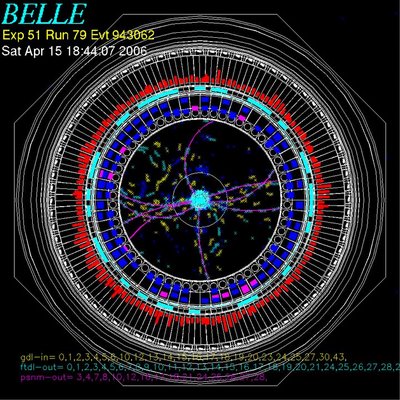Field Trip 2
Oops. I was going to upload this yesterday, but I lost the cable to get the photos off the camera. Better late than never. Just thought I’d post a summary of the stuff we saw on the trip.
We left about midday on Friday to go to SPring-8, which is the world’s highest energy synchrotron light source. They have a high-energy beam of electrons, which they steer around a 1.5km storage ring using magnets. Every time they bend the beam it emits a burst of radiation tangent to the ring. Because the radiation is extremely high energy, higher than X-rays for example, it is useful for materials science and life science. For example, they shoot the radiation through crystals and from the way it is absorbed or scattered they can determine their internal structure.
midday on Friday to go to SPring-8, which is the world’s highest energy synchrotron light source. They have a high-energy beam of electrons, which they steer around a 1.5km storage ring using magnets. Every time they bend the beam it emits a burst of radiation tangent to the ring. Because the radiation is extremely high energy, higher than X-rays for example, it is useful for materials science and life science. For example, they shoot the radiation through crystals and from the way it is absorbed or scattered they can determine their internal structure.
The following photo was taken at the laser reverse Compton scattering experimental hutch, where Nakano claimed to have found the first evidence for the pentaquark Theta in 2002. The results are still controversial, and haven’t been consistently confirmed by other experiments, so they are setting up a new experiment so they can take more data in the near future.
 After we finished the tour of SPring-8 we went to Harima Observatory.
After we finished the tour of SPring-8 we went to Harima Observatory.  It’s one of the major Observatories in Japan, hidden in the mountains in the middle of Hyogo prefecture, about an hour’s drive northwest of Kobe. It was supposed to be dark, but the light pollution from Himeji and Okayama was still pretty bad. On the bright side, the weather was clear and we had a good view through the big telescopes as well as just looking at the stars from outside. It’s not normally possible to see more than a handful of stars in Osaka or Tokyo or Tsukuba. Professor Tsunemi took the following shot of Saturn, although it didn’t come out nearly as good as it looked through the scope.
It’s one of the major Observatories in Japan, hidden in the mountains in the middle of Hyogo prefecture, about an hour’s drive northwest of Kobe. It was supposed to be dark, but the light pollution from Himeji and Okayama was still pretty bad. On the bright side, the weather was clear and we had a good view through the big telescopes as well as just looking at the stars from outside. It’s not normally possible to see more than a handful of stars in Osaka or Tokyo or Tsukuba. Professor Tsunemi took the following shot of Saturn, although it didn’t come out nearly as good as it looked through the scope.

We left about
 midday on Friday to go to SPring-8, which is the world’s highest energy synchrotron light source. They have a high-energy beam of electrons, which they steer around a 1.5km storage ring using magnets. Every time they bend the beam it emits a burst of radiation tangent to the ring. Because the radiation is extremely high energy, higher than X-rays for example, it is useful for materials science and life science. For example, they shoot the radiation through crystals and from the way it is absorbed or scattered they can determine their internal structure.
midday on Friday to go to SPring-8, which is the world’s highest energy synchrotron light source. They have a high-energy beam of electrons, which they steer around a 1.5km storage ring using magnets. Every time they bend the beam it emits a burst of radiation tangent to the ring. Because the radiation is extremely high energy, higher than X-rays for example, it is useful for materials science and life science. For example, they shoot the radiation through crystals and from the way it is absorbed or scattered they can determine their internal structure.The following photo was taken at the laser reverse Compton scattering experimental hutch, where Nakano claimed to have found the first evidence for the pentaquark Theta in 2002. The results are still controversial, and haven’t been consistently confirmed by other experiments, so they are setting up a new experiment so they can take more data in the near future.
 After we finished the tour of SPring-8 we went to Harima Observatory.
After we finished the tour of SPring-8 we went to Harima Observatory.  It’s one of the major Observatories in Japan, hidden in the mountains in the middle of Hyogo prefecture, about an hour’s drive northwest of Kobe. It was supposed to be dark, but the light pollution from Himeji and Okayama was still pretty bad. On the bright side, the weather was clear and we had a good view through the big telescopes as well as just looking at the stars from outside. It’s not normally possible to see more than a handful of stars in Osaka or Tokyo or Tsukuba. Professor Tsunemi took the following shot of Saturn, although it didn’t come out nearly as good as it looked through the scope.
It’s one of the major Observatories in Japan, hidden in the mountains in the middle of Hyogo prefecture, about an hour’s drive northwest of Kobe. It was supposed to be dark, but the light pollution from Himeji and Okayama was still pretty bad. On the bright side, the weather was clear and we had a good view through the big telescopes as well as just looking at the stars from outside. It’s not normally possible to see more than a handful of stars in Osaka or Tokyo or Tsukuba. Professor Tsunemi took the following shot of Saturn, although it didn’t come out nearly as good as it looked through the scope.



